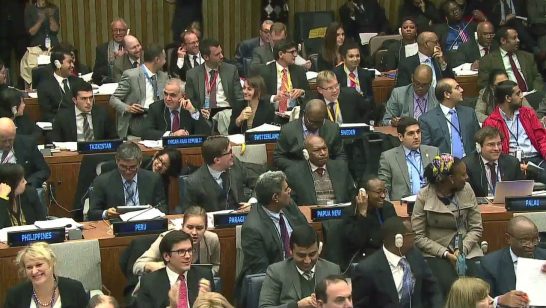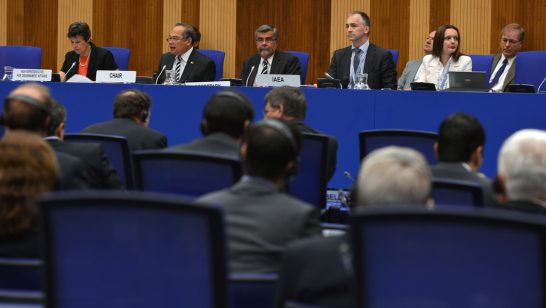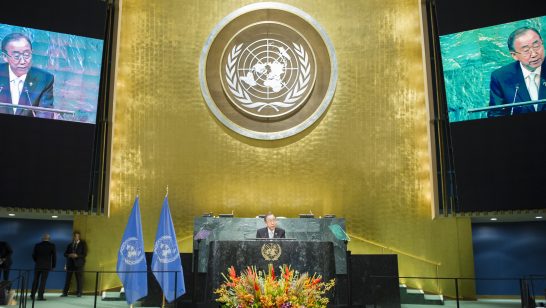
On July 7th, 2017, 122 nations agreed to prohibit nuclear weapons. It took 72 years after their first and only use. In her deeply moving closing statement, Setsuko Thurlow, an atomic bomb survivor, said, “This is the beginning of the end of nuclear weapons.”
Reaching agreement on the treaty had taken three international conferences on the catastrophic consequences of nuclear weapons, a humanitarian pledge signed by over 100 states, and a UN Open-ended Working Group agreeing to start negotiations on a prohibition treaty. The treaty is, above all, a humanitarian achievement, recognizing the indiscriminate nature and uniquely destructive power of nuclear weapons. It will have to be ratified by 50 states to come into force.
In October 2016, there was a UN vote preceding these negotiations. The vote reflected not only the current crisis of the Nuclear Non-proliferation Treaty (NPT), but also the deterioration in the global security situation. The five nuclear weapon states to whom the NPT gives the right to nuclear weapons, although subject to a demand for their eventual complete dismantlement, all voted against the negotiations; so did the states protected by the nuclear weapons of others, with the exception of the Netherlands, which abstained.
Of the nuclear-armed states outside the NPT, Israel voted against the negotiations and India and Pakistan abstained. North Korea voted in favour. One hundred and twenty three states without nuclear weapons voted in favour. An illustration of the divisive nature of the vote was that the Nordic States, as a rule supportive of a humanitarian agenda and disarmament, voted across the whole spectrum. Sweden voted in favour and participated in the negotiations. Finland abstained and did not participate. Norway and Iceland, as NATO states, were pressured by the US to vote against. Denmark not only voted against, but the Danish ambassador to the UN stood alongside US Ambassador, Nikki Haley, during the protest she organized outside the UN negotiating room in March 2017
None of the nine nuclear weapon states participated in the “ban” negotiations. No-one expects these states either to abolish their weapons or to observe the related modernization plans stemming from the treaty. Setsuko Thurlow may have to wait for a long time for the “beginning of the end”. However, the treaty has forced the nuclear weapon states to react. Not only did the US ambassador to the UN stage a protest, the nuclear weapon states also claim that the new treaty will undermine the NPT and that it has polarized the nuclear field.
Polarization is a fact, not only between the states with nuclear weapons and those without, but also inside non-nuclear weapon states. During negotiations, a number of the non-nuclear states saw the new treaty as complementary to the NPT, believing that it would both strengthen the NPT and enforce its Article VI on nuclear disarmament. On the opposing side, the more ‘NPT- frustrated’ majority see the new treaty as one standing in its own right. In their view, the NPT´s “grand bargain” between disarmament and non-proliferation has become distorted. The NPT treaty is, increasingly, regarded as being only a treaty to prevent proliferation. Now there is also a disarmament treaty.
These divisions are reflected in the verification debate. Like the NPT, the new treaty defines the Comprehensive Safeguards Agreement as the minimum level for verification. The Additional Protocol is not mentioned. The nuclear weapon states fear “forum-shopping”, where non- nuclear states might try to hide their interest in nuclear weapons by choosing between the NPT and the ban treaty. The group of states that sees the new treaty as a complement to the NPT would have liked to see the Additional Protocol as the minimum standard. The states that see the new treaty as one in its own right were satisfied with the safeguards as a minimum. A number of them have not themselves ratified the Additional Protocol.
Although the nuclear-armed states will continue to defend their nuclear weapons, many aspects of the nuclear non-proliferation regime will change. No country will have, any longer, a legal right to nuclear weapons; when the new treaty is ratified, these weapons will not only be de-legitimized, they will, in addition, be stigmatized. Civil society will have a new instrument at its disposal. Furthermore, nuclear conferences for years to come will debate the relationship between the NPT and the “ban” treaty. Until now, the states which played down the problems with the NPT traditionally defended it by saying, “This is the only treaty we have.” This argument no longer applies.
The opinions articulated above represent the views of the author(s), and do not necessarily reflect the position of the European Leadership Network or any of its members. The ELN’s aim is to encourage debates that will help develop Europe’s capacity to address the pressing foreign, defence, and security challenges of our time.



